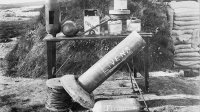








The Livens Projector was a simple mortar-like weapon that could throw large drums filled with flammable or toxic chemicals.
Invention History
It was created by the British army officer Captain William H. Livens of the Royal Engineers.Later, in World War II he worked on petroleum warfare weapons such as the flame fougasse and various other flame throwing weapons.A large calibre flame thrower, designed to engulf German trenches in burning oil, was deployed at the Somme in 1916. Prior to the invention of the Livens Projector, chemical weapons had been delivered either by "cloud attacks" or chemical-filled shells fired from howitzers. Cloud attacks at first were made by burying gas-filled cylinder tanks just beyond the parapet of the attacker's trenches and then opening valves on the tanks when the wind was right. This allowed a useful amount of gas to be released but there was danger that the wind would change and the gas would drift back over the attacking troops. Chemical shells were much easier to direct at the enemy but could not deliver nearly as much gas as a cylinder tank.
Livens was in command of Z company, the unit charged with developing and using flame and chemical weapons. Flame throwers and various means of dispensing chemicals had proven frustratingly limited in effect. One day, during an attack on the Somme, Z company encountered a party of Germans who were well dug in. Grenades did not succeed in shifting them, so Livens improvised a sort of giant Molotov cocktail using two 5 gallon oil drums. When these were thrown into the German positions they were so effective that Livens's comrade Harry Strange wondered whether it would be better to use containers to carry the flame to the enemy rather than relying on a complex flame thrower.